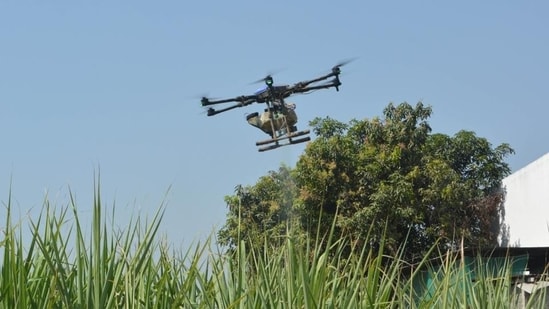The word “drone” refers primarily to unmanned aircraft guided by remote control or onboard computers. The drone sector is a sunrise sector in India with the potential to significantly impact defence, surveillance, internal security, disaster management, agriculture, healthcare, geo-spatial mapping, mining, infrastructure, and aerial photography and cinematography, among many other areas.
Despite numerous uses, drones are considered synonymous with strategic military usage. In a recent incident involving the hijacking of Liberian flagged vessel MV Lila Norfolk near Somalia, wherein 15 Indian crew were involved, the Indian Navy in a swift operation deployed maritime patrol aircraft and its Predator MQ9B drones to launch an emergent action and promptly rescued the Indian crew.
India first used military drones during the 1999 Kargil war with Pakistan, where Israel supplied India with IAI Heron and Searcher drones for reconnaissance. Since then India has procured numerous military unmanned aircraft from Israel, and the US.
The Defence Research and Development Organisation (DRDO) has also developed its own domestic Unmanned Aerial Vehicle (UAV) or Unmanned Aircraft Systems (UAS) programme. The project aims to develop a domestic arsenal to replace and augment the existing fleet of unmanned vehicles.
Drones have played a significant role in the ongoing conflict between India and Pakistan. In June 2021, drones were used by Pakistan to carry out a targeted attack on the Indian Air Force station in Jammu, marking a new escalation in the use of unmanned aerial systems in cross-border hostilities, met by a swift and effective response by India.
Drones have been utilised by India in border surveillance and monitoring activities in regions like Ladakh when tensions between India and China continue to cause concerns and demand alertness. Drones helped in enhancing situational surveillance and monitoring enemy activities.
The growth in the strategic sunrise sector is currently driven by the military for surveillance and strengthening internal security. However, the government is also utilising drones to tackle challenges in various sectors and other uses. During the Covid-19 pandemic, the government used indigenously developed drones to deliver Covid-19 vaccines to remote areas of Manipur, Nagaland, Jammu and Kashmir, and Andaman and Nicobar Islands. In 2020, the Indian Army used drones to deliver essential medical supplies to remote areas of Nepal during the Covid-19 pandemic. The drones provided faster and more efficient means of transportation, overcoming the challenges of difficult terrain and limited accessibility.
The Indian Navy has used drones for maritime surveillance and security operations in the waters surrounding Sri Lanka. Drones assist in monitoring maritime activities, ensuring the safety of shipping lanes, and preventing illegal activities such as smuggling and piracy. The anti-swarm drone ammunition serves as an essential tool in bolstering national security. The Indian Navy has developed an indigenous navigation system and an anti-swarm drone, capable of building walls around its own warships or assets to protect them from any attack by enemy drones, said officials.
In a major boost towards attaining Aatmanirbharta, the Indian Navy recently received the first indigenously made the UAV, “Drishti 10 Starliner” from the Adani Defence and Aerospace, a major private sector manufacturing company in India. This was lauded by the Chief of Naval Staff Admiral R Hari Kumar, hoping that the drone “may turn out to be a third eye in the sky” for securing the maritime domain witnessing increasing challenges of conflict.
The ministry of defence had contracted Adani Defence and Aerospace about 10 months ago to supply four medium altitude long endurance (MALE) drones to the Indian Navy and Indian Army. Both will get two each in the next few months.
As extensively highlighted in the media, Drishti is an advanced surveillance and reconnaissance platform with 36 hours of endurance and 450 kg payload capacity. It’s the only all-weather military platform with NATO’s STANAG 4671 (standardised agreement 4671) certification for the UAV system’s airworthiness.
As a part of the Aatmanirbhar Bharat policy, the government approved the Production-Linked Incentive (PLI) scheme with an allocation of ₹120 crore spread over three financial years for drones and drone components. The government has released a provisional list of 23 PLI beneficiaries, including 12 drone manufacturers and 11 drone component manufacturers. The FY 2022-23 budget announced the Drone Shakti scheme to promote start-ups for Drone-As-A-Service (DrAAS). It also announced the courses for skilling in select ITIs in all states.
The contribution of the private sector in the military drone industry will provide a tremendous strategic advantage and heft to Indian defence. India currently has over 200 drone startups. Given the potential and evolving technology in this sector, the number will substantially increase. To ensure that India has trained drone operators, several government and private institutions have started training programmes. Indira Gandhi Rashtriya Uran Akademi, an autonomous body under the aegis of the ministry of civil aviation and one of the largest flight training organisations in the country, started DGCA-certified training at India’s first and exclusive drone flying site in Gurugram in February 2021.
Considering the growing challenges in the neighbourhood and geo-strategic needs, it is extremely important that India acquires aatmanirbharta in this strategic field as early as possible and develops indigenous manufacturing capabilities and innovative technologies. As new advances are taking place around the globe, India cannot afford to lag.
Dhanendra Kumar is formerly secretary, Defence Production, executive director at the World Bank for India, Sri Lanka, Bangladesh and Bhutan, first chairman, Competition Commission of India. He is currently chairman of Competition Advisory Services India LLP. The views expressed are personal
 Unmanned Aerial Vehicle The latest drone news
Unmanned Aerial Vehicle The latest drone news




